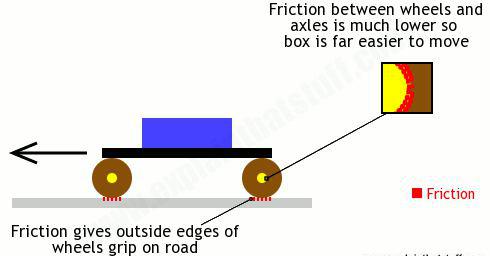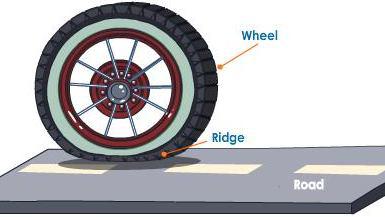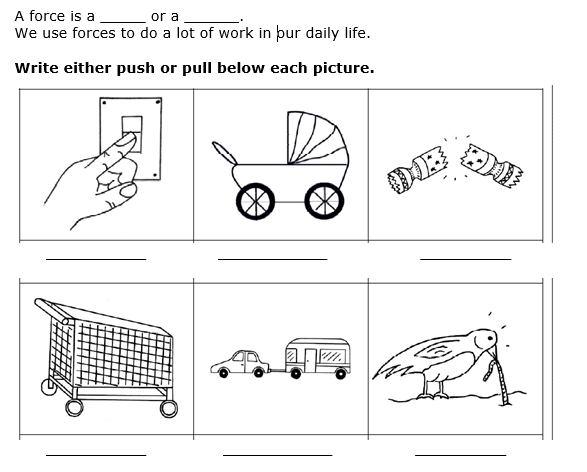| Simple tools |
|---|
| Force and movement |
| Wheels |
| Assessments |
A force is a push or a pull.
Watch this video to learn about force and movement
A force is a push or a pull of an object.
If a push or a pull is applied to a book on your desk, we say the force has acted on the book whether the book changed its position or not.
The harder you push or pull an object the greater the force you use.
This means we apply more force on heavier objects than on lighter ones.
Gravity is an example of a force because it pulls objects downwards towards the earth.
Similarly, friction is a force because it acts in the opposite direction that force is applied.
Friction opposes the motion.
Force is measured in Newtons.
The symbol for Newton is N.
Force can be measured using a spring balance.
1 Kg is equal to 10N
Friction is a force that opposes motion.
Friction acts between two surfaces that are in contact or that move over each other. e.g. the book on the table.
When you rub your hands together you feel some resistance that is caused by friction.
If you continue rubbing your hands rapidly then you will feel some heat or warmth in your hands.
This is an effect of the force of friction.
Friction has both advantages and disadvantages in our daily lives.

There is more friction between the shoes and the grass than the snow and the snowblades.

The wheel in contact with the road exhibits rolling friction.

Force of friction can be increased by:
Oil or grease is applied to the hinges of doors and windows to reduce friction.
Engines and machines are lubricated with oil to reduce friction.


Standard 5
1. Juma sat on the seesaw at point P while John sat at point Q. the seesaw tilted lifting John up. Which one of the following should John do in order to balance with Juma?
A. Move nearer the fulcrum
B. Remain at Q and press the seesaw downwards?
C. Move the fulcrum closer to himself
D. Move further away from the fulcrum
2. Four children Reka, Yaba, Fatuma, and Zaina were trying to balance on a see-saw. They did this in pairs. The results were as shown in the diagram below.

Which one among the children was the heaviest?
A. Reka B. Yaba C. Fatuma D. Zaina
Standard 6
1. Sarah made a model of a windmill from scrap metal. She noticed that it turned slowly. To increase the speed of turning she would.
A. Reduce the number of blades.
B. Increase the area of the blades.
C. Grease the blades.
D. Reduce the size of the blades.
2. Which one of the following statements is true about a moving object? It
A. Keeps on moving even if a force acts on it.
B. Keeps reducing its speed even if no force acts on it
C. Continues moving in a straight line unless a force acts on it
D. It requires no force in order to accelerate.
1. It is easier to walk on swampy ground when one is wearing flat shoes than when wearing pointed shoes because.
A. Flat shoes create more friction than pointed shoes.
B. Mass of flat shoes is greater than mass of pointed under flat shoes.
C. Pressure exerted is greater under pointed shoes than under flat shoes.
D. Force of gravity is greater o flat shoes than on pointed shoes
Standard 7
1. The chart below shows some information about four different liquids P, Q, R, and S.

Which of the four liquids would be most suitable for lubricating moving parts of a bicycle?
A. Liquid P B. Liquid Q C. Liquid R D. Liquid S
2. A teacher taught his pupils that hard materials are NOT scratched easily. One of his pupils then tested several materials in pairs to find out which one scratch the other. Her results were as shown in the table below.
|
SOLID |
SOLID |
SOLID WHICH WAS SCRATCHED |
|
Plastic Glass Wood Iron Plastic Wood |
Wood Iron Glass Plastic Glass Iron |
Wood Iron Wood Plastic Plastic Wood |
The order of solids from the hardest to softest is
| A. Wood, |
plastic, |
iron, |
glass |
| B. Iron, |
glass, |
wood, |
plastic, |
| C. Plastic, |
iron, |
glass |
wood |
| D. Glass, |
iron, |
plastic, |
wood |
3. In which one of the following activities is friction LEAST useful?
A. Teacher writing on blackboard B. Shutting a door
C. Cutting wood with a saw D. A person walking
4. Nafula had two plastic blocks of 5kg and 10kg. She measured the force of friction between each block and different surfaces. Her results were as shown in the table below.
|
Type of surface |
Mass of plastic block pulled along the surface(kg) |
Force of friction(N) |
|
Rough wood |
5 10 |
11 15 |
|
Smooth wood |
5 10 |
4 6 |
|
Rough metal |
5 10 |
8 10 |
|
Smooth metal |
5 10 |
2 4 |
Nafula had two plastic blocks of 5kg and 10kg. She measured the force of friction between each block and different surfaces. Her results were as shown in the table below.
Which one of the following statements is WRONG according to the information in the table?
A. Increasing the mass of the plastic block also increases the force of friction
B. The smooth metal surface creates less force of friction than the smooth wood surface
C. The force of friction on any metal surface is always less than on any wood surface
D. Making any of the surfaces smoother reduces the force of friction
5. In which one of the following activities does a man need to reduce friction?
A. Walking downhill B. Writing on a piece of paper
C. Sliding a carton of milk across a table D. Picking bottles from a crate
6. Mary cut four pieces from a yam whose shapes are as shown in the diagrams below.

She then held each piece by the top and pushed it downwards in a jar containing water. Which one of the pieces would Mary find easier to push down?
A. K B. L C. M D. N
7. It is easier to push a box across while placed on rollers than without them. This is because the rollers,
A. make the floor slippery. B. reduce friction.
C. raise the box height. D. make the box lighter.
8. Two pupils found it difficult to push a heavy wooden box of books along the floor. Which one of the following methods would enable them to pull the box more easily?
A. Greasing the floor surface
B. Pouring fine sand on the floor
C. Placing rollers beneath the box
D. Pouring water in the floor
9. The diagrams below show various shapes of objects. The objects are made of the same material and of the same weight.

The order in which the objects would sink in water starting with the fastest to the slowest is:
A. G, F, E, H B. E, H, G, F C. F, G, H, E D. H, E, G, F
10. A needle was dropped through columns of four liquids of different rates of flow. The time taken for the needle to reach the bottom of each column is shown in the table below.
|
Liquid |
W |
X |
Y |
Z |
|
Time taken (sec) |
6 |
1 |
5 |
2 |
Which one if the liquids can be used as a lubricant?
A. W B. X C. Y D. Z
11. Friction is a force which
A. Accelerates motion B. Produces motion
C. Opposes motion D. Changes direction of motion